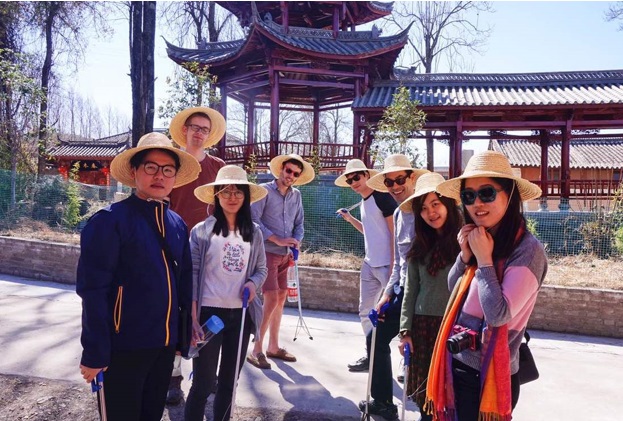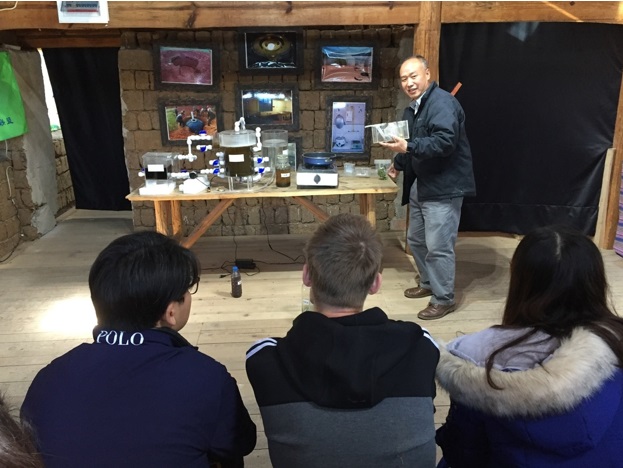Green Education Center: Projects and Goals
The TSDM Cohort began its Yunnan research trip investigating environmental protection efforts in Lijiang. Nestled between mountains, rivers, and springs in the northwest of the province, Lijiang is famous for its ancient old town (a UNESCO World Heritage site) and the natural beauty of its surrounding environment. As the region has become more popular and accessible for tourists, the city faces new challenges to protect its iconic natural landscape.
TSDM students were hosted by the Green Education Center, a local non-profit organization devoted to fostering environmentally sustainable and socially responsible behavior in the local community. Our in depth interviews with the Center’s Director, Chen Yongsong, as well as Center staff, provided a comprehensive overview of the development of the center, the NGO landscape and many environmental challenges in the region.
Development of the Center
The development of the Green Education Center mirrors the development of many other NGOs in the region. Civil society interest in the environment can be dated to 1999, when Kunming, the capital of Yunnan Province, hosted the World Horticultural Exposition. This event highlighted the importance of environmental protection, and the incredible diversity of the province.
Afterwards, there was a growing environmental consciousness in the province; however, at the time Yunnan lacked the technical expertise and financial resources to significantly address environmental protection. Yunnan began welcoming in foreign NGOs, in cooperation with the Chinese government, to establish environmental protection programs and build sustainable environmental development initiatives within the province.
However, many of these foreign NGOs focused on short and medium term programs of 3-4 years, after which time the project would end or foreign staff would depart. Local staff still in place following these departures had developed a wealth of experience and knowledge and began taking more and more of a leadership role in NGOs. GEC was born out of this new core of local leaders committed to bettering their community.
Green Education Center’s place in the Local NGO landscape
One of the primary research goals of the cohort was to investigate the role of and challenges faced by NGOs in Yunnan. GEC Director Chen provided a broad overview of the challenges and strategies faced by his organization as a case study of the larger NGO landscape in the province. One theme of his remarks was the importance of autonomy—maintaining a clear and focused vision as an independent organization that guides their work. Independence of action can impact cooperation with the government as well as other NGOs; when asked about the role and activities of foreign NGOs in the region, Director Chen framed the decision to partner as a question over autonomy. Many foreign organizations and donors have their own vision and priorities for projects, which may not align with the local experience and mission of GEC, he said. Director Chen also notes that many are not flexible in adapting projects to reflect changes in circumstances or local expertise, which can hamper efforts to build fruitful partnerships between foreign and local organizations.
NGOs and the Government
Director Chen shared that the GEC, and local NGOs in general, can fill an important niche in environmental protection efforts. While the government is typically concerned with larger, macro level projects like coal power plant pollution, water pollution, etc., other important but smaller issues may get lost. Through funding and partnership from the government, NGOs can work on independent projects arising from citizen concerns and have an impact on significant but overlooked issues in the community. In addition, NGOs partnering with larger government initiatives that together have a force multiplier effect on environmental protection. He cited the example of a biomass energy scheme in Yunnan. The government will pay to have large biomass tanks stored in local houses to generate cleaner energy, reduce demand on the grid, and alleviate local pollution; at the same time, NGOs like GEC help promote the program and encourage its adoption by local communities.
GEC’s priority is building environmental consciousness among the next generation, and raising environmental awareness among the local community to change hearts and minds towards environmental protection. The cohort investigated two main projects of the Center:
A. Leave No Trash Behind Program
A pledge not to litter, the Leave No Trash Behind Program consists largely of targeted outreach to schools and local institutions to educate students and young people of the importance their actions have in building a clean and more beautiful community. GEC partners with influential relevant stakeholders like the Communist Youth League to present at over 400 local primary schools and those outside the province, like the International School of Beijing, as well as a media campaign that has resulted in appearances on NHK TV and local media. The center had also partnered with the World Bank and US State Department, among other organizations, to promote its campaign. By the end of 2015, over 510,000 people had signed the pledge.
B. Biomass
With the rise of the local tourism industry there has been an explosion in the number of horse farms devoted to breeding horses for tourist recreation; the consequent rise in manure and other waste has had a significant impact on the local environment. GEC encourages local farmers to harness their biowaste to power their homes. The biomass can be human, from toilets and kitchens, or from animals and farms. By harnessing this waste, biomass tanks can reduce the amount of water pollution and provide cleaner energy sources for the region. This project is an example of NGO-government partnerships. 60% of population has installed biomass generators, thanks to government subsidy. The government will fund construction but GEC advocated for increased training, education on usage for locals to increase the program effectiveness, which has since become official policy.
In addition, GEC is in the midst of a Precision Poverty Alleviation Project, promoting the installation of solar panels and selling excess energy back to the grid.
Funding
GEC is funded partly by the government, and partly through private donors. To protect its independence, Director Chen is transitioning to a more sustainable funding model by transforming the Center into a more fully developed educational hub, targeting students
from elementary school to graduate school to come learn about projects and view their impact on the ground. He is looking to partner with local farmers who could host tourists, giving them a glimpse of local culture which building the Center’s profile in the community. Through these activities, he hopes to combine his educational mission with self-sustainability.
Community Volunteers
Following this overview, the cohort joined the director in an excursion to a local lake to experience life as volunteer at center and witness firsthand the persistent challenges tourism has brought to regional environment. Because of an influx of tourists, waste and litter has taken big toll on environment; the cohort helped clean the lake area and shadowed director in engagement efforts with local farmers and vendors. That evening, the cohort also enjoyed a discussion with Center interns, high school students who are part of additional outreach efforts to local schools.
At the conclusion of the visit, the cohort returned to Lijiang in preparation for the next phase of the journey.



